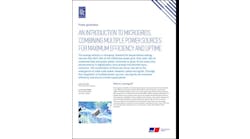We fret about turning off the lights to save pennies on energy. Meanwhile, electricity worth billions of dollars gets lost or stolen on the world’s power grids every year.
In industry jargon, the problem is known as ‘line loss.’ A certain amount of electricity generated by a power plant never makes it to the consumer – or at least the paying consumer. Instead it is lost or diverted somewhere over the wires. Some of it dissipates in transit for technical reasons. In other cases, it’s pilfered by marijuana growers, households, or in some countries even manufacturers.
Awesense, a Canadian company that has built its business model around solving this problem, pegs the cost of worldwide electricity loss at $202 billion annually.
Losses vary dramatically by country, with percentages running in the double digits in Brazil, China and India. In the US, about seven percent of the power generated goes missing. How much of that is theft? No hard figures exist, but a rule of thumb for sophisticated grids puts US power theft at two to three percent. That may not sound like a lot, but the US is one of the world’s biggest power producers. So even a small percentage of electricity lost means a large amount of fossil fuel wasted.
So, in a time when we strive for greater energy efficiency, why don’t we hear more about this problem?
It’s a matter of accountability and who pays, according to Mischa Steiner-Jovic, CEO of Awesense. Regulators typically do not require utilities to absorb the costs. Instead, electricity ratepayers subsidize the thievery.
“The utility commission has not sufficiently motivated the utility to reduce its losses. Because the utilities are able to pass their losses on to the rest of the customers, they are not financially motivated to solve power theft,” said Steiner-Jovic in a recent interview.
That’s not to say, nothing is being done. Some progressive utilities in North America are taking initiative, in part for safety reasons. Utility workers can inadvertently come in contact with wires exposed by setups jury-rigged to divert power.
But North America is still far behind Brazil, where the federal government has put in place a policy to reduce electricity losses. “Energy is such an important factor for the growth of their economy. They can’t afford to lose 20-30 percent of their energy,” said Steiner-Jovic. Brazil’s electricity theft problem has helped spur the installation of smart meters, which can go long way in helping utilities identify loss.
Not all utilities can afford smart meters. And anyway, thieves sometimes maneuver around them. Awesense has developed a system to identify electricity loss for utilities with or without smart meters. The company acts as a kind of energy auditor for the grid, using a combination of software and monitoring equipment to identify where loss is occurring and why – whether the problem is malfunctioning equipment or theft. It then helps the utility put in place a strategy to resolve the problem. Like many energy service companies, Awesense operates under a ‘no upfront cost’ model – it is paid out of the energy savings achieved by the utility.
So far, developing countries have shown the greatest concern about line loss. But Steiner-Jovic predicts that North America, too, will take more notice as the consumer becomes increasingly energy aware.
“It just can’t go on that we turn a blind eye to inefficiency on the grid,” he said. “Energy is too valuable a commodity.”
Elisa Wood is a long-time energy writer whose work has been picked up by CNN, the New York Times, Reuters and the Wall Street Journal. See her articles here: http://www.realenergywriters.com/elisa-wood/






